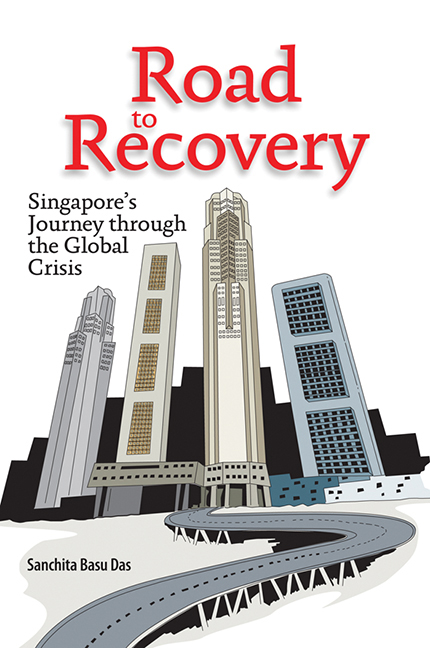Book contents
- Frontmatter
- Dedication
- Contents
- List of Tables
- List of Figures
- List of Boxes
- Foreword
- Acknowledgements
- Abbreviations
- 1 Introduction
- 2 Global Financial and Economic Crisis: Causes, Impact, and Policy Response
- 3 Impact of Global Economic Crisis on Singapore
- 4 Singapore's Policy Responses to the Global Economic Crisis
- 5 Singapore Economic Perspective and Future Policy Directions
- 6 Lessons Learnt
- Appendix I MAS Monetary Policy Statements
- Appendix II Key Budget FY2009 Initiatives
- Appendix III Summary of the ESC Key Recommendations
- Appendix IV Key Budget FY2010 Initiatives
- References
- Index
- About the Author
4 - Singapore's Policy Responses to the Global Economic Crisis
Published online by Cambridge University Press: 21 October 2015
- Frontmatter
- Dedication
- Contents
- List of Tables
- List of Figures
- List of Boxes
- Foreword
- Acknowledgements
- Abbreviations
- 1 Introduction
- 2 Global Financial and Economic Crisis: Causes, Impact, and Policy Response
- 3 Impact of Global Economic Crisis on Singapore
- 4 Singapore's Policy Responses to the Global Economic Crisis
- 5 Singapore Economic Perspective and Future Policy Directions
- 6 Lessons Learnt
- Appendix I MAS Monetary Policy Statements
- Appendix II Key Budget FY2009 Initiatives
- Appendix III Summary of the ESC Key Recommendations
- Appendix IV Key Budget FY2010 Initiatives
- References
- Index
- About the Author
Summary
For Singapore, the recession came mainly through the fall in non-oil exports and output. The monetary and financial systems for the city state largely remained unscathed. The financial shocks were mostly felt through drying up of credit and capital flows due to heightened risk aversion. But, apart from these initial stresses, there were no severe financial dislocations. Inflation and exchange rates remained stable. This was also enunciated by Finance Minister Tharman Shanmugaratnam in his speech while presenting the 2009 budget in Parliament on 22 January 2009. He stated that the key risk facing Singapore was the scale of the recession and loss of jobs rather than inflation.
Hence Singapore carved out policies that could cushion businesses and households from the impact of the economic downturn, maintain confidence in the financial market, and support economic recovery in the long-run.
Policymakers' Objective
The success of Singapore coming out of the crisis depended on the country's policy responses at both the domestic and regional levels. Being a small open economy, the conventional fiscal and monetary policies to boost domestic demand were not very effective. The city state's private consumption and investment have been highly dependent on export demand. Hence, the MAS used the exchange rate mechanism to gradually respond to the external demand shocks that confronted the economy during the intense phase of the crisis. The central bank also aimed for a low inflationary environment and ensured that the Singapore dollar remained an anchor of stability.
Similarly, the FY2009 budget aimed at the supply side of the economy, more particularly in keeping jobs. This was mainly due to Singapore being a significant consumer of imports (import to GDP ratio was more than 200 per cent in 2007 vis-à-vis an average of 81 per cent in Asia), so demand-boosting stimulus measures would be challenged by import leakages.
The policymakers also worked cautiously in tandem with other regional initiatives to preserve confidence in the financial system, which had been wrecked by the huge losses suffered by some of the biggest banks in the United States and the European Union.
- Type
- Chapter
- Information
- Road to RecoverySingapore's Journey through the Global Crisis, pp. 70 - 96Publisher: ISEAS–Yusof Ishak InstitutePrint publication year: 2010

